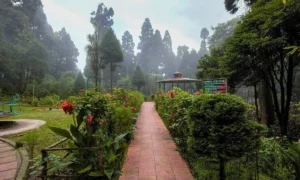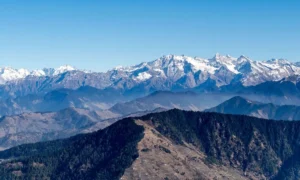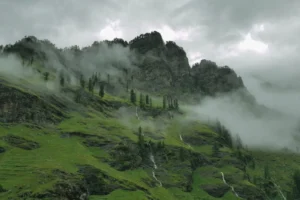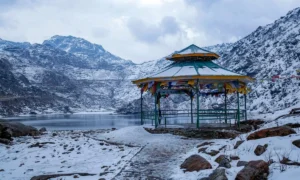Are you dreaming of waking up to the gentle mist of the mountains, surrounded by the lush greenery of a tea plantation? Perhaps you have seen stunning photos of Darjeeling and wondered what it is truly like to live among the tea pickers and experience the process of making one of the world’s finest teas. If you are a tea aficionado or simply someone looking for a unique and peaceful getaway, you have probably heard of Makaibari Tea Estate. This place is more than just a destination; it is an experience that connects you with nature, culture, and the very soul of Darjeeling tea.
Many people have questions about visiting Makaibari Tea Estate. What is it like to stay in a homestay? What activities can you do there besides drinking tea? How do you get there, and what is the best time to visit? This guide is designed to answer all of these questions and more. We will take a journey through the heart of Makaibari, a place that is not just famous for its tea but also for its commitment to biodynamic farming and community empowerment. By the end of this guide, you will have all the valuable, actionable information you need to plan your perfect trip to this tea lover’s paradise. Get ready to discover the magic that lies within the hills of Kurseong, West Bengal, and learn why Makaibari is a truly special place.
Exploring the Heart of Makaibari: A Sustainable Tea Estate
Makaibari, which translates to “Maika’s land” in Nepali, is one of the oldest and most respected tea estates in Darjeeling. It was established in 1859 by G. C. Banerjee, and it holds a special place in the history of tea production. What sets Makaibari apart is its deep commitment to biodynamic farming, a method that treats the entire estate as a single, living organism. Instead of using chemicals, Makaibari relies on natural cycles and a rich ecosystem to produce its exceptional tea. The estate is a vibrant mosaic of tea bushes, forests, and small villages, all working together in harmony.
The Biodynamic Farming Philosophy
At Makaibari, you will find a holistic approach to agriculture. The estate is a diverse ecosystem that includes not only tea bushes but also forests with native trees, medicinal plants, and a variety of birds and animals. The farmers use natural compost and plant-based preparations to enrich the soil. This approach not only results in healthier tea but also helps preserve the natural environment. According to the Makaibari management, this philosophy is about creating a “tea garden where people, plants, and animals co-exist in harmony.” When you visit, you can see this philosophy in action, from the compost pits to the lush, thriving forests.
The Makaibari Homestay Experience
One of the most authentic ways to experience Makaibari is to stay with a local family in a homestay. This is not a typical hotel stay; it is an opportunity to immerse yourself in the local culture and lifestyle. Families who host visitors are an integral part of the Makaibari community. You will eat home-cooked meals, learn about local customs, and perhaps even participate in daily village life.
The homestays are simple yet comfortable, providing a cozy and warm environment. Staying at a homestay offers a truly unique perspective on life in a tea plantation. You can sit with your host family in the evening, sharing stories and learning about the history of the region. This is a chance to build a personal connection and truly understand the spirit of Makaibari.
What to Do at Makaibari: Activities for Every Visitor
A trip to Makaibari Tea Estate is filled with a variety of engaging activities. Whether you are interested in the tea-making process, local culture, or simply enjoying the peaceful landscape, there is something for everyone.
1. The Tea Factory Tour
This is the highlight for most visitors. A guided tour of the tea factory provides a fascinating look into how tea is made. You will learn about the entire process, from plucking the tea leaves to the final packaging. The tour guides, who are often long-time residents of the estate, will explain each step:
- Plucking: Learning about the art of plucking the “two leaves and a bud.”
- Withering: The process of spreading leaves to reduce moisture.
- Rolling: Machines that gently roll the leaves to break down cell walls and release juices.
- Fermentation/Oxidation: The critical step that gives Darjeeling tea its unique flavor.
- Drying: Stopping the fermentation process with heat.
- Sorting and Packaging: Preparing the final product for sale.
You will see the historic machinery and smell the distinct aroma of different tea stages. The tour culminates with a tea tasting session, where you can sample some of Makaibari’s finest products, including the famous Silver Tips Imperial tea.
2. Nature Walks and Bird Watching
Makaibari is a haven for nature lovers. The estate is home to a rich variety of flora and fauna, making it an excellent spot for nature walks. The well-maintained trails wind through tea bushes, dense forests, and clear streams. You might spot a variety of birds, including exotic Himalayan species. The peaceful atmosphere and beautiful scenery make for a truly refreshing experience. A morning walk through the tea gardens, with the mist slowly lifting, is an unforgettable moment.
3. Community and Cultural Immersion
The Makaibari community is vibrant and welcoming. During your visit, you can spend time with the local villagers. You might see them working in the fields or celebrating a festival. The estate’s commitment to community empowerment is evident in various projects, such as a school for the children of the workers and a clinic. You can learn about their traditions, their music, and their way of life. This interaction provides a much deeper understanding of the region than a typical tourist visit.
Information for Planning Your Trip to Makaibari Tea Estate
How to Get in Makaibari Tea Estate
Makaibari Tea Estate is located near Kurseong, a small town about 30 kilometers from Darjeeling.
- By Air: The nearest airport is Bagdogra (IXB). From the airport, you can hire a taxi to Makaibari. The drive takes approximately 2-3 hours, depending on traffic and road conditions.
- By Train: The nearest major railway station is New Jalpaiguri (NJP). From there, you can hire a car or take a shared jeep to Kurseong and then to Makaibari. The journey by road from NJP is similar to that from the airport.
- By Road: Makaibari is well-connected by road from Siliguri, Darjeeling, and other nearby towns. The scenic drive through the hills is an experience in itself.
Best Time to Visit Makaibari Tea Estate
The best time to visit Makaibari is during the spring (March to May) and autumn (September to November). The weather during these months is pleasant, with clear skies and comfortable temperatures. This is also when the tea leaves are at their best for harvesting, so you can see the gardens in full production. The monsoon season (June to August) brings heavy rainfall, which can make travel difficult, although the landscape is exceptionally green and beautiful. The winter months (December to February) can be quite cold, but the clear, crisp air and stunning views are a reward in themselves.
Kurseong Attractions: Distances from the Makaibari Tea Estate, Kurseong
| Destination | Approximate Distance from Museum | Approximate Travel Time |
| Eagle’s Crag (E.C) | 3.1 km | 14 minutes (by car) |
| Giddapahar View Point | 6.4 km | 20 minutes (by car) |
| Dow Hill Eco Park (Deer Park) | 9.5 km | 31 minutes (by car) |
| Netaji Subhash Chandra Bose Museum | 6.6 km | 20 minutes (by car) |
| Giddapahar Seti Mata Mandir | 5.9 km | 18 minutes (by car) |
| Ambotia Shiva Mandir | 6.9 km | 25 minutes (by car) |
| British-era Churches and Schools | 7.5 km | 24 minutes (by car) |
| Bhangzang Salamander Lake | 18.9 km | 49 minutes (by car) |
| Ambootia (Ambotia) Tea Estate | 5.9 km | 21 minutes (by car) |
| Forest Museum, Dowhill | 8.1 km | 28 minutes (by car) |
| Castleton and other gardens | 1.5 km | 4 minutes (by car) |
FAQs (Frequently Asked Questions) Makaibari Tea Estate
1. Is a prior booking required to visit Makaibari Tea Estate?
Yes, it is highly recommended to book your tour or homestay in advance, especially during the peak season. This ensures that the guides and hosts are prepared for your visit and can give you their full attention.
2. What is the difference between Makaibari’s various teas?
Makaibari produces a variety of teas, including Darjeeling First Flush, Second Flush, and the famous Silver Tips Imperial. The difference lies in the time of year the tea is harvested and the processing method, which gives each tea its unique flavor profile.
3. What is the cost of a homestay at Makaibari?
The cost of a homestay varies depending on the number of people and the duration of the stay. It usually includes accommodation and meals. It is a very affordable and enriching experience compared to staying in a hotel.
4. Can I buy tea directly from the estate?
Yes, you can purchase fresh, authentic Makaibari tea directly from the estate’s shop. This is a great way to take home a piece of your experience and enjoy some of the world’s best tea.
5. Is Makaibari suitable for children?
Yes, Makaibari is a great destination for families. Children can learn about nature, farming, and different cultures in a safe and engaging environment. The homestay experience can be particularly educational for them.
Conclusion
A visit to Makaibari Tea Estate is much more than a simple holiday; it is a journey into the heart of a community that lives in harmony with nature. From the fascinating tea factory tour and the serene nature walks to the warmth of a local homestay, every moment at Makaibari is filled with genuine experiences. You will not only learn about the art of making fine tea but also gain a deep appreciation for the sustainable practices and the people who make it all possible.
So, if you are looking for a unique and meaningful travel experience, consider Makaibari. Take the next step and plan your trip, or share this guide with a friend who might be dreaming of a similar adventure.
Have you ever visited a tea plantation? What was your favorite part? Share your thoughts and questions in the comments below!



